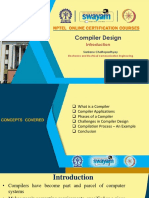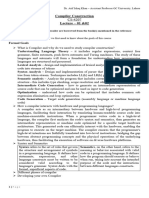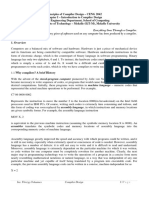Compilers
Uploaded by
jafameg801Compilers
Uploaded by
jafameg801A compiler is a fundamental tool in the field of computer science and software
development. It plays a crucial role in translating high-level programming languages
into machine code that can be executed by a computer's central processing unit
(CPU). Let's delve into the introduction and history of compilers:
Introduction to Compilers: A compiler is a software program that takes the
source code of a high-level programming language as input and transforms it into an
equivalent program in a lower-level language, typically machine code or assembly
language. The primary purpose of a compiler is to facilitate the execution of a
program on a computer by converting it into a form that the hardware can
understand and execute efficiently
History of Compilers: The history of compilers dates back to the early days of
computing, and it has been marked by several key milestones:
1940s and 1950s: Early Days of Computing and Assembly Language
In the early days of computing, programming was done using machine code,
which consisted of binary instructions directly understandable by the
computer's hardware.
Assembly languages were introduced as a step up from raw machine code.
Assembly languages used symbolic mnemonics to represent machine code
instructions, making it somewhat easier for programmers to write and
understand code.
Programmers had to write code manually for specific computer architectures,
which was time-consuming and error-prone.
1950s: The Birth of High-Level Programming Languages
The need for more efficient and accessible programming led to the
development of high-level programming languages like Fortran (1957) and
LISP (1958).
Fortran, designed by John Backus and his team at IBM, was one of the first
high-level languages. It was created to make scientific and engineering
calculations more accessible.
LISP, developed by John McCarthy, was designed for symbolic computing and
artificial intelligence research.
1950s and 1960s: The Emergence of Early Compilers
With the introduction of high-level languages, the concept of a compiler began
to take shape.
Fortran's compiler, developed by IBM, was an early example of a compiler that
translated high-level Fortran code into machine code.
The ALGOL 60 language and its compiler, developed in the late 1950s, laid the
foundation for future programming languages.
1970s: The Rise of C and C++
Dennis Ritchie's creation of the C programming language in 1972 and its
compiler played a pivotal role in the history of compilers.
The C language's portability and efficiency made it an excellent choice for
system programming and led to the development of Unix, which was largely
written in C.
C++ (1983), an extension of C with object-oriented programming features,
further influenced compiler technology.
1980s and 1990s: Compiler Optimization and Language Diversity
Compilers evolved to perform advanced optimization techniques, making
generated code more efficient.
The proliferation of programming languages, including languages like Pascal,
Ada, and later Java, required the development of various compilers for each
language.
Late 20th Century: Just-In-Time (JIT) Compilation and Dynamic Compilation
JIT compilers, which translate code into machine code at runtime, gained
prominence with languages like Java and .NET. These compilers allow for
platform independence and runtime optimization.
Dynamic compilation techniques, such as adaptive optimization, became more
prevalent, enabling programs to adapt to changing runtime conditions.
21st Century: Specialized Compilers and New Paradigms
Specialized compilers for domains like graphics (shader compilers) and
database systems (SQL compilers) emerged.
The development of domain-specific languages (DSLs) led to the creation of
specialized compilers tailored to specific tasks.
The rise of functional programming languages like Haskell, Erlang, and Rust
introduced new challenges and opportunities for compiler design.
Recent and Future Developments: Quantum, AI, and Beyond
The advent of quantum computing is expected to require entirely new
compiler techniques to translate high-level quantum programming languages
into quantum machine code.
AI and machine learning will likely play a role in optimizing compilers,
detecting and fixing bugs, and assisting in code generation.
Energy efficiency and security considerations will continue to influence
compiler design.
The development of cross-platform and cross-language compilers will help
meet the growing demands of diverse software development environments.
Working of compiler
The working of a compiler is a complex process that involves several stages, each of
which contributes to the transformation of high-level programming code into
machine code or assembly language that can be executed by a computer. Here is an
elaboration of the working of compilers:
1. Lexical Analysis (Scanning):
The process begins with lexical analysis, where the source code is
scanned character by character.
The scanner identifies and groups characters into tokens, which are the
smallest units of meaning in the programming language. Tokens may
include keywords, identifiers, constants, operators, and punctuation.
Whitespace and comments are often removed during this stage.
2. Syntax Analysis (Parsing):
After lexical analysis, the compiler performs syntax analysis to
determine the structure of the program.
This stage uses a formal grammar that defines the language's syntax
rules. The result is a syntax tree or an abstract syntax tree (AST) that
represents the hierarchical structure of the code.
Syntax analysis checks that the code adheres to the language's
grammar rules.
3. Semantic Analysis:
Semantic analysis follows syntax analysis and focuses on the meaning
of the program.
It checks for type consistency, variable declarations, and other semantic
rules. If there are errors, such as undeclared variables or type
mismatches, the compiler reports them.
Additionally, this stage may perform constant folding and other
optimizations.
4. Intermediate Code Generation (Optional):
Some compilers generate an intermediate representation of the code at
this point, which is closer to machine code but still abstract.
Intermediate code simplifies subsequent stages of the compilation
process and can be used for optimization.
5. Code Optimization:
Code optimization is a crucial phase in compiler operation. The
compiler analyzes the code to improve its efficiency.
Various optimizations are applied, such as constant propagation, dead
code elimination, loop unrolling, and common subexpression
elimination, to make the program run faster and use fewer system
resources.
6. Code Generation:
In this stage, the compiler generates target code that is executable on
the specific hardware platform.
The compiler translates the intermediate representation or the syntax
tree into machine code or assembly language.
Register allocation and instruction selection are critical aspects of code
generation, as they affect the performance of the generated code.
7. Symbol Table Management:
Throughout the compilation process, the compiler maintains a symbol
table, which is a data structure that stores information about variables,
functions, and other identifiers used in the code.
The symbol table is used to resolve identifiers, check for scope and
type-related errors, and facilitate code generation.
8. Error Handling and Reporting:
At various stages of compilation, the compiler checks for errors and
reports them to the programmer. Error messages help developers
identify and fix issues in their code.
The compiler may also provide warnings for potential issues that do
not prevent compilation but could lead to unexpected behavior.
9. Linking (Optional):
In some cases, especially in multi-file programs, a linker is used to
combine multiple object files or libraries into a single executable
program. Linkers resolve references to external functions and variables
and establish the final memory layout of the program.
10. Output Generation:
The final output of the compiler is an executable binary file or assembly code
that can be executed by the computer's CPU.
The working of a compiler is a highly intricate process that involves analysis,
transformation, and optimization of source code. Compilers play a crucial role in
making programming languages accessible and efficient, as they enable
programmers to write code in a high-level language while ensuring that it can run on
diverse hardware platforms.
Types of compiler
Compilers can be categorized into different types based on their functionality, target
platform, and usage. Here are some common types of compilers:
1. Single-Pass Compiler: A single-pass compiler processes the source code in a
single pass or sweep, from start to finish, without revisiting any code. It
generates machine code or an intermediate representation in one go. Single-
pass compilers are typically faster and require less memory but may have
limitations in performing certain optimizations.
2. Multi-Pass Compiler: In contrast to single-pass compilers, multi-pass
compilers go through multiple phases or passes when processing the source
code. Each pass performs specific tasks, such as lexical analysis, syntax
analysis, semantic analysis, and code generation. Multi-pass compilers often
produce more optimized code but may be slower and require more memory.
3. Front-End Compiler: A front-end compiler is responsible for the initial stages
of compilation, including lexical analysis, syntax analysis, and semantic
analysis. It generates an intermediate representation of the source code. The
front-end is often platform-independent and can be used with different back-
ends for various target architectures.
4. Back-End Compiler: The back-end compiler takes the intermediate
representation generated by the front-end and translates it into machine code
or assembly language specific to a particular target platform. Back-end
compilers are usually platform-dependent and optimized for a specific
architecture.
5. Optimizing Compiler: Optimizing compilers focus on improving the
efficiency and performance of the generated code. They apply various
optimizations, such as constant folding, loop unrolling, and dead code
elimination, to make the program run faster and use fewer system resources.
6. Just-In-Time (JIT) Compiler: JIT compilers are used in runtime environments,
such as Java or .NET, to translate bytecode or intermediate code into machine
code just before execution. This allows for platform independence and can
lead to improved performance as the compiler can make optimizations based
on the actual execution environment.
7. Ahead-Of-Time (AOT) Compiler: AOT compilers translate the entire source
code into machine code or a binary executable before execution. This
contrasts with JIT compilation, which translates code during runtime. AOT
compilation is common in languages like C and C++ and results in fast, native
code execution.
8. Cross-Compiler: Cross-compilers are designed to generate code for a
different target platform than the one on which the compiler itself runs. They
are useful for creating software for embedded systems, different architectures,
or platforms with limited resources.
9. Source-to-Source Compiler: Source-to-source compilers, also known as
transpilers, convert source code from one high-level programming language
to another. They are commonly used for porting code between languages or
for optimizing code for different platforms.
10. Bootstrapping Compiler: A bootstrapping compiler is a compiler for a high-
level language that is initially written in a lower-level language (often
assembly language or another programming language). Once the high-level
language compiler is complete, it can be used to recompile itself. This process
is known as bootstrapping and is commonly used to develop self-hosted
compilers.
11. Specialized Compilers: Some compilers are designed for specific tasks or
domains. For example, shader compilers are used in graphics programming to
translate shader code into instructions for GPUs, and SQL compilers translate
SQL queries into execution plans for database systems.
These are some of the common types of compilers, each serving different purposes
and having its own set of features and optimizations. The choice of compiler type
depends on the programming language, target platform, and specific requirements
of the development process.
Scope and Future advancement of compilers
The future of compilers is closely tied to the evolution of programming languages,
hardware architectures, and the demands of software development. While it's
challenging to predict specific advancements, we can identify some key trends and
potential directions for the future of compilers:
1. Improved Optimization Techniques: Compiler optimization will continue to
advance, leading to more efficient and faster code generation. Machine
learning and AI may be employed to enhance code optimization by making
better decisions based on program behavior and execution profiles.
2. Parallel and Distributed Computing: As multi-core processors and
distributed computing become more prevalent, compilers will need to
optimize code for parallelism and distributed systems. This includes automatic
parallelization of code and efficient use of GPU accelerators.
3. Quantum Computing: The development of quantum computing will likely
require new types of compilers to translate high-level quantum programming
languages into instructions for quantum processors. Quantum compilers will
need to manage the unique characteristics of quantum computing, such as
superposition and entanglement.
4. Security and Code Analysis: Compilers will continue to play a vital role in
improving code security. Future compilers may offer enhanced code analysis
and vulnerability detection to mitigate security risks, including memory-
related vulnerabilities and code injection attacks.
5. Polyglot Compilers: With the increasing use of multiple programming
languages in a single project, polyglot compilers that seamlessly support and
optimize different languages will become more important.
6. Dynamic Compilation: Dynamic compilers, such as Just-In-Time (JIT)
compilers, will continue to evolve to adapt to changing runtime conditions
and take advantage of dynamic optimization opportunities.
7. Quantum Computing for Compiler Optimization: Quantum computing
itself can be used to optimize compilers. Quantum computers have the
potential to perform complex optimization tasks that are currently too time-
consuming for classical computers, which can lead to more efficient and faster
compiler development.
8. Energy Efficiency: Given the growing concern about energy consumption
and environmental impact, compilers will need to focus on energy-efficient
code generation and optimization to reduce the power consumption of
software.
9. AI-Powered Compilers: Artificial intelligence and machine learning will likely
play a role in future compilers. This could involve using AI to automatically
detect and fix bugs, recommend optimizations, or assist in code generation.
10. Cross-Platform Development: With the rise of mobile and web applications,
as well as IoT devices, compilers that can seamlessly target multiple platforms
and architectures will be in demand. Cross-platform compilers will simplify the
development process and improve code portability.
11. Custom Hardware Accelerators: Compilers will need to support the creation
of custom hardware accelerators, such as Field-Programmable Gate Arrays
(FPGAs) and Application-Specific Integrated Circuits (ASICs). These
accelerators can be optimized for specific workloads and provide significant
performance advantages.
12. Human-Readable Code Generation: Future compilers may produce more
human-readable code, which can aid in debugging, maintenance, and code
understanding. This could be especially valuable in generated code from
higher-level languages.
The future of compilers will depend on the rapid advancements in computer
technology, the emergence of new programming paradigms and languages, and the
evolving needs of the software development industry. As software continues to play
a critical role in various domains, compilers will remain at the forefront of the tools
that enable developers to write efficient, secure, and portable code.
You might also like
- Rift Valley University Department of Computer ScienceNo ratings yetRift Valley University Department of Computer Science35 pages
- Learning Materials, CD, Unit-1 (Btech-5th Sem)No ratings yetLearning Materials, CD, Unit-1 (Btech-5th Sem)12 pages
- Compiler Design Mini Project Sakshi GuptaNo ratings yetCompiler Design Mini Project Sakshi Gupta7 pages
- compiler-design-notes-v1u1t1-introduction-of-compilerNo ratings yetcompiler-design-notes-v1u1t1-introduction-of-compiler5 pages
- Indian Institute of Information Technology, Bhagalpur: Assignment - 1No ratings yetIndian Institute of Information Technology, Bhagalpur: Assignment - 126 pages
- Lecture 1 Intro To Programming LanguagesNo ratings yetLecture 1 Intro To Programming Languages6 pages
- System Programming (BTCS-405A) Session:jan-May, 2018: ContentsNo ratings yetSystem Programming (BTCS-405A) Session:jan-May, 2018: Contents10 pages
- Compiler Design.: Why To Learn About CompilersNo ratings yetCompiler Design.: Why To Learn About Compilers12 pages
- Sir Chhotu Ram Ins. of Engg and Technology: Srs Report On CompilerNo ratings yetSir Chhotu Ram Ins. of Engg and Technology: Srs Report On Compiler8 pages
- Chapter 1 Introduction To Compiler DesignNo ratings yetChapter 1 Introduction To Compiler Design13 pages
- Dakshina Ranjan Kisku Associate Professor Department of Computer Science and Engineering National Institute of Technology DurgapurNo ratings yetDakshina Ranjan Kisku Associate Professor Department of Computer Science and Engineering National Institute of Technology Durgapur31 pages
- Compiler Theory: 001 - Introduction and Course OutlineNo ratings yetCompiler Theory: 001 - Introduction and Course Outline33 pages
- Compiler Construction: Mohamed Zahran (Aka Z) Mzahran@cs - Nyu.eduNo ratings yetCompiler Construction: Mohamed Zahran (Aka Z) Mzahran@cs - Nyu.edu37 pages
- Introduction To Compiler Design (CD) : Mu-MitNo ratings yetIntroduction To Compiler Design (CD) : Mu-Mit22 pages
- Programming Language and Compiler Design SessionNo ratings yetProgramming Language and Compiler Design Session33 pages
- Water Level Monitoring and Control System Using Float SwitchNo ratings yetWater Level Monitoring and Control System Using Float Switch11 pages
- Information Retrieval: Recent Advances and Beyond: Kailash Hambarde, and Hugo ProençaNo ratings yetInformation Retrieval: Recent Advances and Beyond: Kailash Hambarde, and Hugo Proença26 pages
- Shneiderman's Eight Golden Rules of Dialog DesignNo ratings yetShneiderman's Eight Golden Rules of Dialog Design3 pages
- Lesson Plan Observation INTRODUCTION TO HTML100% (1)Lesson Plan Observation INTRODUCTION TO HTML3 pages
- Make Up - V - VII - Sem B.E. Time Table - 2021-22No ratings yetMake Up - V - VII - Sem B.E. Time Table - 2021-223 pages
- IBM Storage for Hybrid Cloud - L1 Quiz NEWNo ratings yetIBM Storage for Hybrid Cloud - L1 Quiz NEW9 pages
- A.I (Alien Invasion) Guard: Android-Based Tower Defense GameNo ratings yetA.I (Alien Invasion) Guard: Android-Based Tower Defense Game16 pages
- Rift Valley University Department of Computer ScienceRift Valley University Department of Computer Science
- Code Beneath the Surface: Mastering Assembly ProgrammingFrom EverandCode Beneath the Surface: Mastering Assembly Programming
- compiler-design-notes-v1u1t1-introduction-of-compilercompiler-design-notes-v1u1t1-introduction-of-compiler
- Indian Institute of Information Technology, Bhagalpur: Assignment - 1Indian Institute of Information Technology, Bhagalpur: Assignment - 1
- System Programming (BTCS-405A) Session:jan-May, 2018: ContentsSystem Programming (BTCS-405A) Session:jan-May, 2018: Contents
- Sir Chhotu Ram Ins. of Engg and Technology: Srs Report On CompilerSir Chhotu Ram Ins. of Engg and Technology: Srs Report On Compiler
- Dakshina Ranjan Kisku Associate Professor Department of Computer Science and Engineering National Institute of Technology DurgapurDakshina Ranjan Kisku Associate Professor Department of Computer Science and Engineering National Institute of Technology Durgapur
- Compiler Theory: 001 - Introduction and Course OutlineCompiler Theory: 001 - Introduction and Course Outline
- Compiler Construction: Mohamed Zahran (Aka Z) Mzahran@cs - Nyu.eduCompiler Construction: Mohamed Zahran (Aka Z) Mzahran@cs - Nyu.edu
- Water Level Monitoring and Control System Using Float SwitchWater Level Monitoring and Control System Using Float Switch
- Information Retrieval: Recent Advances and Beyond: Kailash Hambarde, and Hugo ProençaInformation Retrieval: Recent Advances and Beyond: Kailash Hambarde, and Hugo Proença
- A.I (Alien Invasion) Guard: Android-Based Tower Defense GameA.I (Alien Invasion) Guard: Android-Based Tower Defense Game

























































































